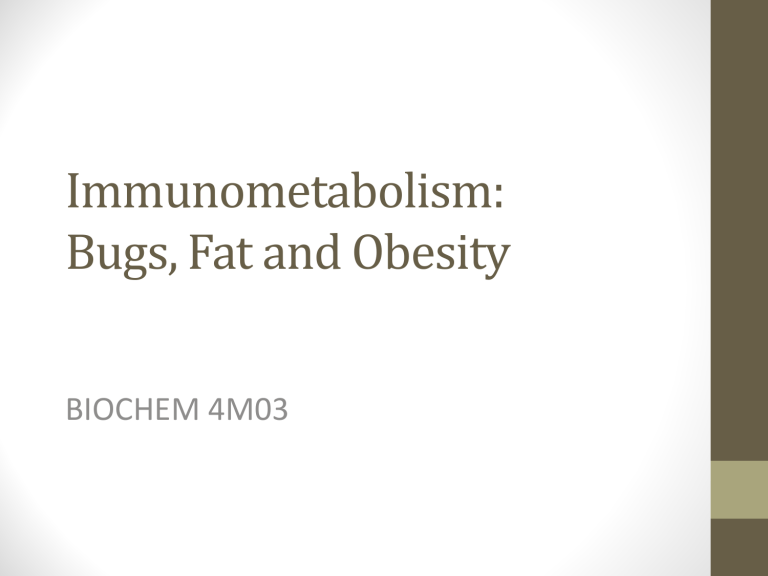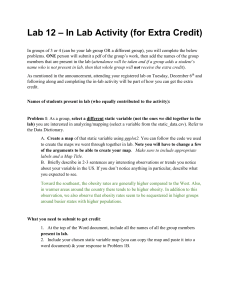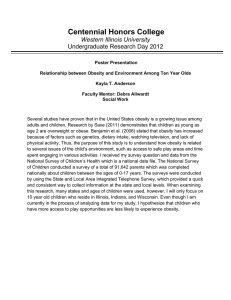
Immunometabolism: Bugs, Fat and Obesity BIOCHEM 4M03 Last lecture: Beta cell • Glucose metabolism inhibits CPT-1 • Inhibits fat oxidation • Promotes accumulation of lipid intermediates • E.g. Ceramide: • Impairs insulin secretion and production insulin Poitout et al., BBA: 1801, 289–298, 2010 Last Lecture INFLAMMATION • Attempt to resolve harmful stimuli • Not always successful • Mounting this attempt can be fatal • Can promote dysfunction and disease METABOLIC INFLAMMATION • Potential Triggers • Food itself • Energy excess = self-harm detection/response • Promote entry of foreign/harmful agent Last Lecture METABOLIC INFLAMMATION • Inflammation associated with obesity and metabolic disease • Contributes to metabolic dysfunction • Higher inflammatory tone in specific tissues or cells • Occurs in key metabolic tissues (liver, adipose, muscle) • Immune cells within these tissues • More immune cells (expansion, infiltration) • More proinflammatory in nature • Impairs insulin action in metabolic cells Last Lecture METABOLIC INFLAMMATION • Relationship between nutrients and bacteria 1. Nutrients engage pattern recognition receptors • Saturated Fat and Toll-like receptors 2. Nutrients or obesity promote invasion of bacterial bits • Obesity and Lipopolysaccharide • More on this today Integration of lipid and inflammatory insulin resistance Overview • Where can obesity come from? Energy balance • Where can inflammation come from? Energy balance • Food • Microbiota • Metabolic inflammation • Obesity • This is as contemporary as I can make it Obesity: Population • We eat more Obesity: Population • Obesity = calories in > calories out • Exercise can reverse obesity • Running wheel in cages of obese mice We expend less • Significant barriers to population exercise • Getting a locker at the McMaster gym Church et al., PLoS One, 2010 Obesity: Energy is conserved • There is no such thing as a free lunch Why is this important? • Obesity predisposes for many diseases Communicable disease (… and getting eaten) http://www.diabeteshypertension.com/ Non-communicable Disease (… eating) Surprise! The gut is involved in obesity & inflammation Microbiota: Weighs ~2 Kg Microbiome has ~3M genes compared to < 30K human genes RECENT UPDATE! # of Bacterial cells on “you” = # of humans cells • Not 10x more bacteria Provide triggers for inflammation in obesity? Regulate energy balance? So … How important are bugs? “High end” fecal transplant: Improves insulin sensitivity Intestinal infusion: Allogenic = lean to obese, Autologous = obese to obese No effect Each one of these people: Decreased insulin resistance No change in fat or body mass Vrieze et al., Gastroenterology, 2012 Gut: Nutrient and bacterial barrier Nutrients Bugs Obesity Inflammation Hooper, Nature Reviews Microbiology, 2009 Specific (parts of) bacteria subvert the gut barrier? A lot = sepsis A little … metabolic endotoxemia Neves A L et al. J Mol Endocrinol 2013;51:R51-R64 Context ??? Bugs in the gut Bacterial parts inside our bodies Inflammation Insulin resistance Metabolic endotoxemia Diet contributes to circulating levels of bacterial components Mice Amar et al., Am J Clin Nutr, 2008 This happens fast … After a single meal Man Erridge et al., Am J Clin Nutr, 2007 Metabolic endotoxemia Obesity contributes to metabolic endotoxemia The gut microbiota contribute circulating endotoxin Insulin resistant Genetically obese +Antibiotics Less insulin resistant Cani et al., Diabetes, 2008 Obesity Type of bugs in the gut Bacterial parts inside our bodies Inflammation Disease (Insulin resistance) Can our bugs influence obesity? What do bugs contribute to or control? What community of bacteria dominates? Fatness or leanness? How to study the importance of bugs? What happens to metabolism if there are no bacteria? Bugs control fat storage Germ free mice • Less fat tissue Compared to: • Born with microbes • 2 week exposure to microbes (“CONV-D”) Despite • Eating more • Burning less energy at rest Bacteria influence gut energy extraction Bäckhed F et al. PNAS 2004;101:15718-15723 Bugs control fat storage Germ free mice • Less fat in critical metabolic tissues Liver • Less triglyceride build-up • Lower levels of enzymes in fat storage Bäckhed F et al. PNAS 2004;101:15718-15723 Concept: Microbiota alter energy extraction We are not germ-free … What about obesity? What about factors that change the microbiota? Obesity: Energy extraction Energy in feces • Obese mice extract more energy • Less energy in the feces Calories in (Mouth) Calories absorbed (Gut) Calories excreted Turnbaugh, Nature, 2006 Changing bugs: Antibiotics (Impairment in the microbiota) • Dysbiosis in during a critical developmental window promotes obesity • “Early-life” antibiotics = increased fat mass Control Antibiotics Antibiotics Cho et al., Nature, 2012 Antibiotics We all share bugs Is obesity a communicable disease? Control your bugs Transmissible obesity? • Transferring the bugs from genetically obese mice increases body fat in recipient mice Transfer “Flora” Obese mouse Lean mouse Lean mouse Lean mouse Lean donor Obese donor “Our” bugs transmit fat storage Donor: Reconstitute germ free mice with human feces • They adopt it and are “humanized” • Feed them a high fat (western) or normal diet Generation 1: • Reconstitute germ free mice with human bugs from mice fed a western or normal diet • Increased fat mass Generation 2: • Repeat • Same result Turnbaugh, Sci Transl Med., 2009 All on normal diet Obesity Normal causing diet diet Gut: Nutrient and bacterial barrier Nutrients Parts of Bugs Obesity Inflammation Hooper, Nature Reviews Microbiology, 2009 Genes and environment • Environmental variation • Bacteria • Food Genes and Environment • Twins have the most similar microbiome • Early life events appear key since monozygotic and dizygotic twins are not different • Obesity reduces variability of the microbiome Turnbaugh, Nature, 2009 leanness dominates Transmissible environment Reconstitute mice with microbiota from obese and lean twins Co-house to promote microbiota exchange Nutrients Microbiota Obesity Co-Housing: Lean overrides obese Ridaura et al., Science, 2013 Bugs and Diabetes Nutrients Bugs Disease susceptibility Obesity Inflammation Hooper, Nature Reviews Microbiology, 2009 Bacteria and Fat Eating lots of fat • Lipid-induced inflammation • Promotes metabolic endotoxemia • Alters the type of bacteria Bacteria • Even just “components” cause inflammation • Alter fat accumulation Fat Bacteria Obesity and Inflammation Disease Where to from here? • Bacteria that live in and on all of us: • • • • Extract nutrients Change during diet/obesity A source of inflammation Transmissible factor relevant to metabolic disease • Modifiable • Needs to be considered regarding therapeutics • Exercise • Diet • Drugs Stay tuned … Rethink? Communicable disease (… and getting eaten) http://www.diabeteshypertension.com/ Communicable Component? Non-communicable Disease (… eating) Thank you • Up next: The basics of cholesterol

